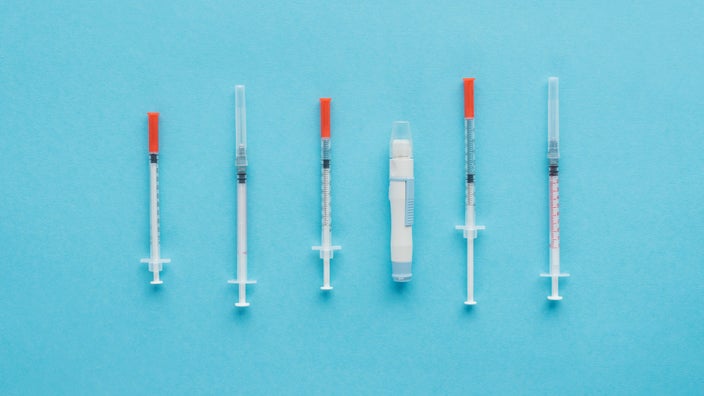
Levemir vs. Lantus: How Do They Compare for Diabetes?
Key takeaways:
Levemir (insulin detemir) and Lantus (insulin glargine) are both long-acting insulins. They’re prescribed to help treat Type 1 and Type 2 diabetes. But Levemir is being discontinued by its manufacturer during 2024. Some prescribers may switch people to Lantus because of this.
Levemir and Lantus are similar in many ways, including in how well they work and what types of side effects they cause. A notable difference between them is that Levemir may require one or two daily doses, while Lantus is usually injected once daily only.
There are many ways to save on Lantus, which is available as reference (“brand-name”) and biosimilar (“generic”) insulins. GoodRx can help make your prescription more affordable.
Access savings on related medications
Table of contents

Insulin has been around for over a century. And it’s a mainstay when it comes to treating Type 1 and Type 2 diabetes. There are many insulin options available, providing people with several possible avenues for treatment. Levemir (insulin detemir) and Lantus (insulin glargine) are two popular ones.
A quick note about Levemir’s discontinuation
In November 2023, Novo Nordisk (Levemir’s manufacturer) announced they would discontinue Levemir on December 31, 2024. This includes both the vials and pens. The decision to discontinue Levemir is based on manufacturing issues and decreased insurance coverage for these products.
Many endocrinologists (diabetes specialists) have already taken steps to prescribe an alternative. Lantus is one of several potential insulins that you could switch to. So it’s normal to have questions about how Levemir and Lantus compare. Below we review the similarities and differences, plus how it’s recommended to convert from Levemir to Lantus.
Why was Levemir discontinued? Read more about Levemir’s discontinuation and possible alternatives.
What side effects can insulin cause? Read about insulin’s side effects — from low blood glucose to weight gain — and how to manage them.
How can you save on insulin costs? Read about the many available savings opportunities for insulin — with or without insurance.
How are Levemir and Lantus similar?
Levemir and Lantus are often prescribed for people living with diabetes who are just beginning to use insulin to help manage their blood glucose (sugar). These two insulins are very similar to each other in a number of ways. Below are four of their most notable similarities.
1. How they work
Levemir and Lantus are both basal insulins. They are long-acting, meaning they work over a period of about 24 hours in your body. This is helpful because you can usually inject them once a day and get their benefits all day long. But as we’ll discuss below, some people may need to inject Levemir twice a day.
Levemir and Lantus are products that people with either Type 1 or Type 2 diabetes can use to manage their glucose levels.
Save on popular GLP-1 Agonists
Take control of your health. With GoodRx, you may be eligible to save even more on popular treatments.

2. Lower risk for low blood sugar
Both Levemir and Lantus may have a lower risk of causing severe hypoglycemia (low blood glucose) compared to insulins that act more quickly, such as Novolin N (insulin isophane human). This seems to be especially true for older adults with Type 2 diabetes. Because Levemir and Lantus work slowly and last longer, people tend to experience more predictable blood glucose levels.
3. Available in vial and pen formats
Levemir and Lantus both come in two formats: a vial and a prefilled pen injector. So both insulins provide flexibility when it comes to choosing an injection device that works for you.
If you choose to use the vial, you will also need syringes to draw up your dose. If you choose the pen injector, you will need needle tips to fit onto the end of the pen.
4. How well they work
Levemir and Lantus are pretty similar when it comes to how well they work and the sort of side effects they might cause.
A systematic review from 2011 showed no meaningful difference between Levemir and Lantus for blood glucose management in people living with Type 2 diabetes. People in the study also experienced similar side effects, regardless of which product they used.
Likewise, a 2018 review of multiple studies found that Levemir and Lantus had similar effectiveness and side effects for people living with Type 1 diabetes.
How are Levemir and Lantus different?
While Levemir and Lantus are very similar, there are some key differences. Below, we cover two that have helped guide healthcare professionals when deciding which medication to prescribe.
1. How often they need to be injected
The biggest difference between Levemir and Lantus is how often they’re injected. Lantus is typically used once a day. But Levemir needs to be injected twice a day in some cases, though injecting once daily is more common.
This is connected to the dose that’s being injected. With lower doses of Levemir, the glucose-lowering effect of the medication seems to wear off around 19 hours after an injection. Higher doses should last for more than 22 hours. Lantus, however, provides glucose balance for about 24 hours regardless of the dose you inject.
2. Whether they have biosimilars versions
Another major difference between Levemir and Lantus is whether or not they have biosimilars available. Lantus has two FDA-approved interchangeable biosimilars: Semglee (insulin glargine-yfgn) and Rezvoglar (insulin glargine-aglr). Levemir doesn’t have any biosimilars available.
A biosimilar is a product that’s very similar to another biologic medication. It may be easier to think of a biosimilar as the generic version of a biologic medication. But because biologics, such as insulin, are more complex to make than non-biologic medications, they don’t have generic versions.
An interchangeable biosimilar takes it one step further. With these, you should be able to switch from one medication to the other without any change in effectiveness or side effects. And, depending on your location, interchangeable biosimilars can sometimes be substituted for the reference (brand-name) biologic by your pharmacist without needing a new prescription.
What are the dosages for Levemir and Lantus, and how are they given?
Both Levemir and Lantus are injected beneath the skin. The exact dosage you’ll use will be unique to you. Your endocrinologist will likely have you start with a low dose and raise it if needed for extra glucose management.
As mentioned above, you may need to inject Levemir once or twice daily. For a once-daily dose, it’s recommended that you inject yourself with your evening meal or at bedtime. For a twice-daily dose, the injections should be separated by about 12 hours. Your evening dose should be injected with dinner or at bedtime.
Lantus is usually injected once a day, at a set time. But there are cases in which some people split larger doses of the medication into two injections at the beginning and end of the day. However, this is uncommon. There’s a more concentrated version of insulin glargine, called Toujeo, that can help people taking high doses avoid twice-daily injections.
Be sure to check out our GoodRx Health article on how to give yourself a shot for tips on how to prepare and inject medications like insulin.
Can you switch from Levemir to Lantus?
Yes, it’s possible to switch from Levemir to Lantus. If you do make the switch, you may have a dose change. Neither insulin’s labeling provides specific Levemir-to-Lantus conversions for dosages. But the American Diabetes Association recommends lowering the number of units you inject daily by 20%. So, if you were injecting 40 units of Levemir daily, you may start by injecting 32 units of Lantus daily.
This is done as a precaution to help avoid hypoglycemia. Depending on your response after switching medications, your daily dose may need to be raised or lowered.
Pharmacist tip: It’s a good idea to work with your diabetes care team to develop your personal Levemir-to-Lantus conversion schedule. You shouldn’t try to adjust your insulin dosage without a healthcare professional’s guidance. Changing insulin dosages on your own could raise your risk of side effects, including hypoglycemia.
What are the side effects of Levemir and Lantus?
Levemir and Lantus have similar side effects. Possible side effects of these insulins include:
Hypoglycemia
Headache
Redness, swelling, or pain where you inject the medication (injection site reactions)
More frequent upper respiratory tract infections, like the common cold
Lipodystrophy (changes to fat distribution in the body, especially around where you inject insulin)
Low potassium levels
Instances of hypoglycemia (glucose lower than 70 mg/dL) can range from mild to severe. Common symptoms of this condition include weakness, dizziness, and sweating. In serious cases, it can be fatal, so it’s important to treat it quickly.
Consuming 15 g of a fast-acting sugar, such as 4 glucose tablets or 1 tbsp of honey, can help correct most cases of mild hypoglycemia. If your glucose is lower than 55 mg/dL, you should seek medical help. This is considered the threshold for severe hypoglycemia, which can cause serious problems, including fainting or seizures.
How to save on Lantus
You can save money on your Lantus prescription with GoodRx discounts, patient assistance programs, and copay savings cards. Here’s more about these different saving options:
Save with GoodRx. GoodRx can help you save over on the average retail price of Lantus SoloStar. Lantus’s price may be as low as $35 per month with a free GoodRx discount.
Save with a copay savings program. If you have commercial insurance, you may be eligible to pay as little as $35 per month for Lantus SoloStar using a savings card from the manufacturer.
Save with patient assistance programs. If you’re uninsured or underinsured, you may be eligible for Lantus’s patient assistance program, which offers the medication free of cost.
Save with a biosimilar. Depending on your location and situation, you may be able to opt for a biosimilar version of Lantus. This may lower costs in some cases. Your diabetes care team can tell you more about Semglee and Rezvoglar, if applicable.
The bottom line
Levemir (insulin detemir) and Lantus (insulin glargine) are two long-acting insulins that share many similarities. They’re similarly effective and can cause comparable side effects. While they’re both often injected once a day, Levemir may require twice-daily injections at lower doses.
Levemir is being discontinued by the end of 2024. Lantus is a potential alternative your prescriber may recommend. Your diabetes care team can help you develop a dose conversion schedule to help you switch from Levemir to Lantus.
Why trust our experts?


References
American Diabetes Association. (n.d.). Insulin basics.
Bradley, M. C., et al. (2021). Severe hypoglycemia risk with long-acting insulin analogs vs neutral protamine hagedorn insulin. JAMA Internal Medicine.
Dietrich, E. A., et al. (2018). Long-acting once-daily insulins: Are there differences in safety or efficacy? Consultant.
Eledrisi, M., et al. (2019). Twice-daily insulin glargine for patients with uncontrolled type 2 diabetes mellitus. Journal of Clinical and Translational Endocrinology.
Kocurek, B., et al. (2018). Switching between insulin products in disaster response situations. Diabetes Disaster Response Coalition.
Novo Nordisk. (2022). Levemir [package insert].
Sanofi-Aventis U.S. LLC. (2022). Lantus [package insert].
Silva, T. B. C., et al. (2018). Effectiveness and safety of insulin glargine versus detemir analysis in patients with type 1 diabetes: Systematic review and meta-analysis. Therapeutic Advances in Endocrinology and Metabolism.
Swinnen, S. G., et al. (2011). Insulin detemir versus insulin glargine for type 2 diabetes mellitus. Cochrane Database of Systematic Reviews.
U.S. Food and Drug Administration. (2023). FDA drug shortages.

























